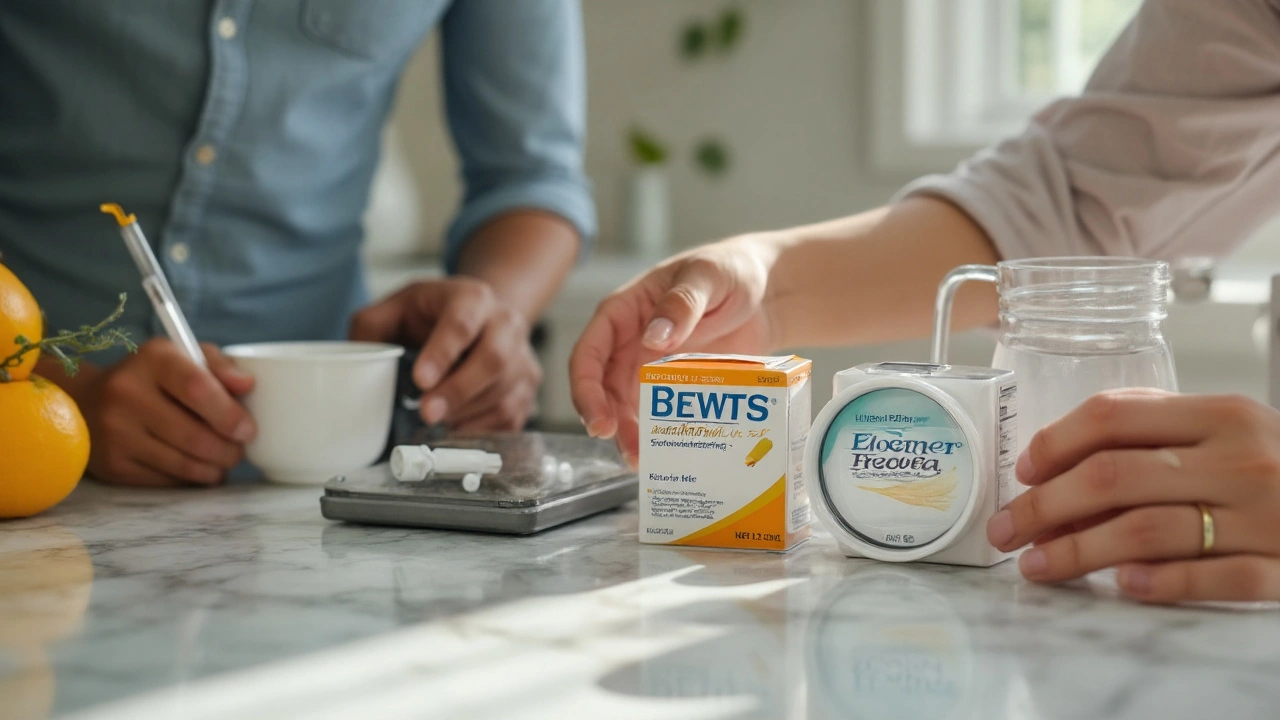You want the same pain and fever relief as the big-name bottle without paying extra-and you want it shipped fast. The catch? Not every low price is a good deal, and not every online seller is legit. Here’s the clean path to buy generic acetaminophen online safely, cheaply, and without wasting time.
What you’ll get here: straight answers on what to buy, how to do the price math, how to avoid counterfeits, and the safety rules that matter. I’ll keep it tight and practical, with numbers you can use at checkout today.
- Pick the right product: strength, form, and bottle size that actually saves money.
- Compare unit price like a pro and stack coupons without getting tricked by shipping or short expirations.
- Buy from safe, licensed sources only-and spot risky sellers fast.
- Use it safely: dose limits, alcohol warnings, kids’ dosing basics, and how to avoid double-dosing in combo cold meds.
- Know when acetaminophen is the better pick vs. ibuprofen or aspirin.
What to Buy: The Right Generic, Strength, and Size
Acetaminophen (also called paracetamol or APAP on labels) is an over-the-counter pain reliever and fever reducer. Generic store brands-Costco’s Kirkland, Walmart’s Equate, Target’s Up&Up, Amazon Basic Care-use the same active ingredient as brand-name Tylenol. You’re paying for packaging and marketing when you buy name brand; the generic usually works the same for typical pain and fever.
How to choose fast:
- Strength: Adults typically choose 500 mg caplets for convenience (fewer pills per dose). The classic strength is 325 mg. Both work; 500 mg often wins on cost-per-gram and simplicity.
- Form: Caplets/tablets are cheapest. Gelcaps cost more, liquids and chewables cost the most per gram. Buy liquids for kids or if swallowing pills is hard.
- Bottle size: Bigger is cheaper per tablet, but only if you’ll use it before it expires. Most household painkiller use is modest; a 200-500-count bottle fits most families for a year or two.
- Label: Look for “Active Ingredient: Acetaminophen.” Avoid products that mix in extras unless you actually need them (like decongestants or sleep aids).
When generic may not be ideal: if you need a very specific form (e.g., rapid-dissolve, dispersible for feeding tubes) or you’re following a clinician’s exact brand guidance. Otherwise, go generic and pocket the difference.
Price Math That Actually Saves You Money
Ignore splashy discounts-focus on unit price. You’re buying milligrams, not marketing. Do this quick calculation before you click purchase:
- Find the price per tablet (cents per tablet).
- Convert to price per gram: (price per tablet) ÷ (mg per tablet ÷ 1000).
- Add shipping and tax to the total and recalc the unit price if shipping isn’t free.
Here’s a 2025 snapshot of realistic online ranges in the U.S. (store brand/generic). Prices vary by retailer, promos, and region:
| Form & Strength | Typical Pack Size | Typical Price Range | Approx. Cost per 500 mg | Shipping Notes | Best For |
|---|---|---|---|---|---|
| Tablets/Caplets 500 mg | 100-500 ct | $3-$12 | $0.01-$0.03 | Free with $25+ or membership; otherwise $3-$6 | Most adults; best value |
| Tablets 325 mg | 100-500 ct | $2-$10 | $0.01-$0.03 | Same as above | Those splitting doses or sensitive to 500 mg |
| Gelcaps 500 mg | 80-200 ct | $5-$14 | $0.02-$0.05 | Often not free unless bundled | Faster swallow preference |
| Liquid (160 mg/5 mL) | 4-16 oz | $4-$10 | $0.05-$0.10 (per 500 mg) | Liquids add weight; watch shipping | Kids, tube feeding, pill aversion |
| Chewables (80 mg or 160 mg) | 24-60 ct | $4-$9 | $0.05-$0.12 (per 500 mg) | Light; shipping varies | Kids who can’t swallow pills |
Three quick ways to trim the total:
- Bundle for free shipping: Add household staples to hit the free-shipping threshold. Recalculate unit price after shipping drops to $0.
- Coupons and subscriptions: On big marketplaces, clip coupons and use “subscribe & save” then cancel later if you don’t want recurring deliveries. Watch that future prices can change.
- Check expiration dates on large packs: Ask the seller’s support to confirm at least 12-18 months dating on 500-count bottles. Short-dated stock can erase your savings.
Red flags on “too cheap”: no physical U.S. address, no pharmacist contact info, claims like “no prescription needed” for prescription drugs, or offers of raw powder without proper labeling. If it feels murky, skip it.

Safety First: Dosing, Overlap Warnings, and Who Should Avoid It
Acetaminophen is safe when used right-and dangerous when overdone. Most accidental overdoses happen from stacking multiple products that all contain it (pain reliever + cold medicine + PM aid).
General adult dosing (U.S.):
- Typical single dose: 325-650 mg every 4-6 hours, or 500-1,000 mg every 6-8 hours as needed.
- Maximum daily dose (without clinician supervision): 3,000 mg in 24 hours. Do not exceed 4,000 mg/day total from all sources even with guidance.
Kids’ dosing basics (always check the label and use the included dosing device):
- Liquid standard: 160 mg/5 mL (U.S.).
- Weight-based: 10-15 mg/kg per dose every 4-6 hours as needed.
- Maximum: 5 doses in 24 hours; do not exceed 75 mg/kg/day.
Key safety rules:
- One acetaminophen at a time: If your cold/flu medicine lists acetaminophen, don’t add extra unless a clinician says so.
- Alcohol: Avoid or limit. More than 2 drinks/day can raise liver risk. Never mix heavy drinking and high doses.
- Liver disease, hepatitis, or chronic malnutrition: Talk to your clinician before any use.
- Warfarin: Acetaminophen can raise INR; if you take warfarin, check with your prescriber about safe limits and extra monitoring.
- Pregnancy: Often preferred over NSAIDs when needed. Use the lowest effective dose for the shortest time. Discuss with your OB if you need frequent use.
- Breastfeeding: Generally compatible; minimal transfer into milk. Confirm dosing and timing with your pediatrician if you’re using often.
“Only buy medicine from state-licensed pharmacies located in the United States. Beware of websites offering prescription medicine without a prescription.” - U.S. Food and Drug Administration, BeSafeRx (2024)
How to check a seller is legit:
- Look for a verifiable U.S. address and phone support with pharmacist availability.
- Check the footer for state pharmacy license info and match it with your state’s Board of Pharmacy look-up.
- Prefer well-known retailers or pharmacies and certifications (e.g., National Association of Boards of Pharmacy .pharmacy program, LegitScript).
- Packaging: Tamper-evident seal, Drug Facts label, lot number, and expiration date are non-negotiable.
Storage once it arrives: Keep it dry, cool, and in original child-resistant packaging. Bedrooms beat bathrooms (humidity kills pills). Don’t leave bottles in hot cars. Most products have a 2-3 year shelf life unopened; always defer to the actual expiration date.
Head-to-Head: When Acetaminophen Beats Ibuprofen-and When It Doesn’t
Acetaminophen reduces pain and fever. It doesn’t reduce inflammation. That’s the line between it and NSAIDs like ibuprofen or naproxen.
Pick acetaminophen when:
- You want pain or fever relief and you have a history of stomach issues, ulcers, or kidney concerns where NSAIDs are risky.
- You’re pregnant and need an occasional pain/fever option; NSAIDs are often avoided, especially later in pregnancy.
- You’re taking blood thinners where NSAIDs may increase bleeding risk (still check interactions).
Pick ibuprofen/another NSAID when:
- The pain is inflammation-driven (sprain, dental swelling, tendonitis). NSAIDs often beat acetaminophen here.
- You need longer action per dose (some NSAIDs last 8-12 hours).
- You don’t have GI bleeding risk, kidney disease, or other NSAID cautions.
Headache, period cramps, fever, sore throat aches-acetaminophen is a solid first choice. For sports injuries with swelling, ibuprofen may do better. Some adults alternate acetaminophen and ibuprofen for tough fevers or pain, but that’s not for everyone; follow label timing carefully and ask your clinician if you have conditions or take other meds.
Combo trap to avoid: PM pain relievers and multisymptom cold/flu products often hide acetaminophen. Read labels every time. The risk isn’t the single dose; it’s the sum across your day.

FAQ and Next Steps: Fast Answers, Red Flags, and Troubleshooting
Quick answers to the questions people ask right before they click “Buy”.
Is generic acetaminophen really the same?
Same active ingredient, same dose, and it has to meet FDA standards for quality and performance. In real life use, the relief is the same for most people.
What’s the cheapest way to buy online?
Choose a 500 mg store-brand bottle in the 200-500 count range, bundle to free shipping, and clip digital coupons. Confirm at least 12 months until expiration. If shipping isn’t free, compare your all-in unit price to local store pickup.
How many tablets will I actually use?
Most households use far less than they think-often 6-12 doses per person per month in cold/flu season and much less the rest of the year. If you rarely need it, a 100-200 count bottle is plenty and avoids waste.
Can I take it with coffee or food?
Yes. Food isn’t required. Caffeine can be in some headache combos, but plain acetaminophen has no caffeine. Stick to water if your stomach is sensitive.
What if I took too much?
If you think you exceeded safe limits or feel unwell (nausea, vomiting, right-upper abdominal pain), call poison control or seek urgent care. Early treatment matters.
Is liquid or chewable more expensive?
Yes, per gram. They’re for kids or people who can’t swallow pills. For adults who can swallow, tablets/caplets are the budget choice.
What about gummies?
Some brands offer acetaminophen in chewable forms; they cost more and can tempt overuse. Keep them out of kids’ reach like any medicine.
Can I combine with alcohol?
It’s safest not to. Regular drinking plus daily acetaminophen raises liver risk. If you drink, keep doses low and infrequent, and avoid back-to-back days.
Pregnancy and breastfeeding?
Acetaminophen is commonly used when needed in pregnancy and is compatible with breastfeeding. Stick to the lowest effective dose, shortest duration, and check with your clinician if you need it often.
How do I spot counterfeits?
Suspiciously low prices, no U.S. address, sketchy labels (no Drug Facts panel, no lot/exp date), broken safety seals, or sellers refusing to confirm expiration dates. Buy from known retailers and licensed pharmacies.
What if my bottle arrived with powdery tablets or a broken seal?
Don’t use it. Photograph the issue, contact the seller for a replacement or refund, and report the seller if they resist. Medicines must arrive sealed and intact.
Can I store it in a pill organizer?
Short term is fine, but keep most of the supply in the original bottle for humidity control and identification. Avoid bathrooms. Cool, dry, dark places win.
What’s the shelf life?
Commonly 2-3 years unopened. Use the printed expiration date as the rule. Once opened, keep the cap tight and avoid moisture.
Next steps (fast plan):
- Decide the form: 500 mg caplets for most adults; liquid or chewables for kids by weight.
- Pick a reputable seller: big-box retailer site or a state-licensed online pharmacy. Confirm license info in the site footer.
- Do the unit-price math and factor shipping. Aim for 1-3 cents per 500 mg tablet in 2025 for large bottles.
- Check expiration dating (ask support if not listed). Look for 12-24 months on big bottles.
- Add to cart with a plan to store it safely and to read the label before the first dose.
Troubleshooting by scenario:
- Super cheap price, unfamiliar site: Stop. Verify U.S. license, contact info, and packaging details. If anything’s off, abandon cart.
- Short-dated large bottle: Ask for a longer date or buy a smaller count. A “deal” you won’t finish is not a deal.
- Need fast delivery during a fever: Compare same-day store pickup or local pharmacy delivery vs. paying for rush shipping. The local option often wins.
- Stomach sensitive: Try with a light snack and water. If you need anti-inflammatory effect, ask your clinician whether an NSAID fits your health profile.
- Multiple meds at once: Lay them on the counter and read each Drug Facts label. If more than one lists acetaminophen, choose only one product at a time.
Credibility notes you can trust: FDA labeling sets strict standards for acetaminophen content and quality. Poison control data consistently shows overdoses come from duplicate products and dose stacking, not from a single labeled dose. Pediatric dosing in the U.S. is standardized at 160 mg/5 mL for liquid, with weight-based dosing at 10-15 mg/kg per dose, max 5 doses per day. When in doubt, call your pediatrician or pharmacist and read the label-every time.
One last reminder: if you have liver disease, drink heavily, or take warfarin, talk to your clinician before using acetaminophen regularly. Saving money starts with buying right; staying safe starts with dosing right.

So you're telling me I can save $10 by buying pills that look like they were printed on a 1998 dot-matrix printer? Cool. I'll just order 5000 tablets from a website that says 'PharmaDreams.com' and call it a day. Who needs liver function tests when you've got free shipping? 😘
Let me guess - you’re advocating for the commodification of pain relief as if it were artisanal kombucha. The FDA standards? Please. Real medicine comes with a white coat, a stethoscope, and a 30-minute consultation where you’re charged $200 to be told to drink water. This post is peak neoliberal healthcare delusion.
Buy from US-licensed pharmacies ONLY. If you're ordering from some Irish guy with a Shopify store named 'AcetaminophenExpress', you're not saving money - you're funding Russian cybercrime. America First, pills last.
EVERYONE knows the government puts poison in generics. They want you dependent. The real cure? Cold showers and faith. Also, why is the bottle not glowing? 🤔
Biggest tip I’ve got: always check the expiration date. I once took a 2019 bottle during a migraine and thought I was hallucinating. Turns out the pills were just… gone. Like, chemically vanished. Now I keep mine in the fridge with my protein powder. 🧊💪
Unit price math is legit - but have you considered the cognitive load of comparing 17 different SKUs while your kid screams for a snack? 🤯 Sometimes the $12 bottle with free shipping and no math is worth the 3 cents extra. Mental bandwidth > micro-savings.
There’s a philosophy here, y’know. We’ve turned medicine into a spreadsheet game. But pain doesn’t care about unit cost. It just wants relief. Maybe the real question isn’t ‘how cheap?’ - but ‘how human?’ Are we treating bodies like inventory? Or are we just trying to survive another Tuesday?
I’m a nurse in rural Ohio and I can’t tell you how many folks show up with counterfeit Tylenol they bought from a ‘discount pharmacy’ on Instagram. The pills were chalky, tasted like plastic, and one lady ended up in the ER. Please - if it looks sketchy, it is. I’ve seen it. Don’t be the next story.
Generic = lazy. If you’re not paying for the brand, you’re paying for regret. 💀 Also, acetaminophen is just sugar water with a fancy name. Try CBD. Or fasting. Or chanting. 🙏
I took 4 tablets because I thought my headache was from stress. Then I threw up for 12 hours. My wife said I was being dramatic. But I wasn’t. I was dying. And now I’m scared to even look at a pill bottle. Can someone just hold my hand?